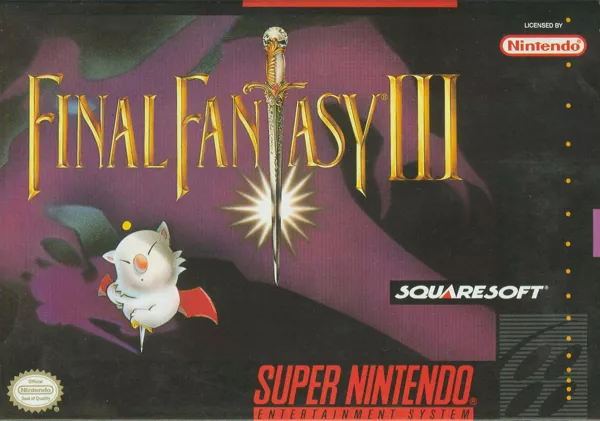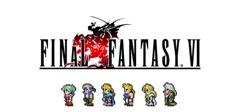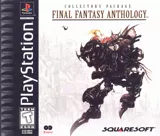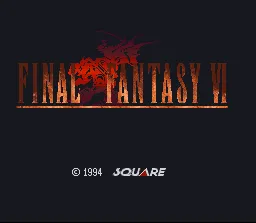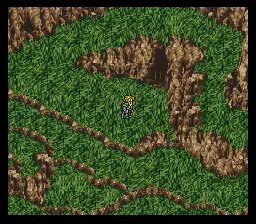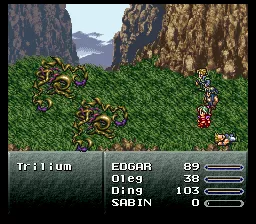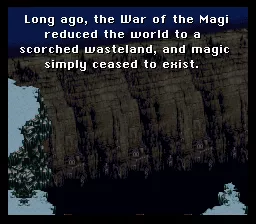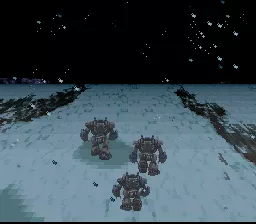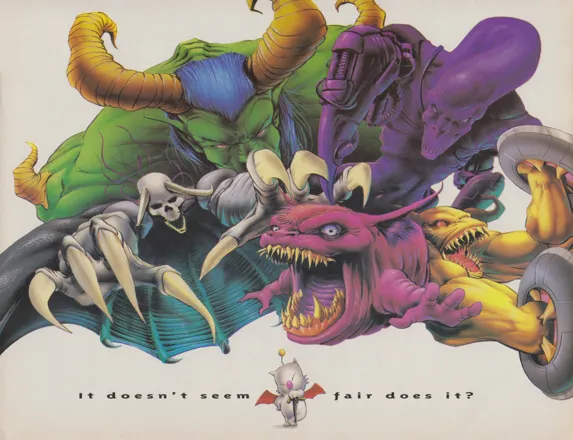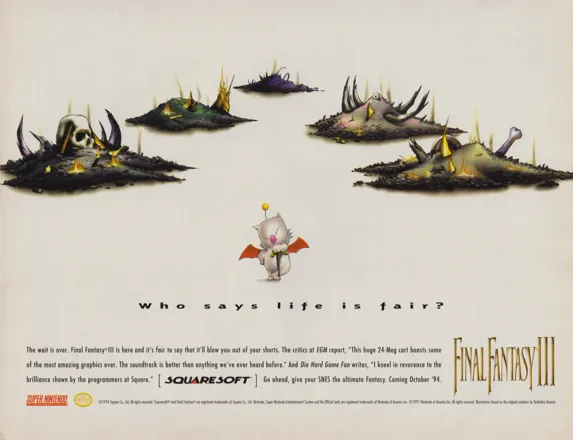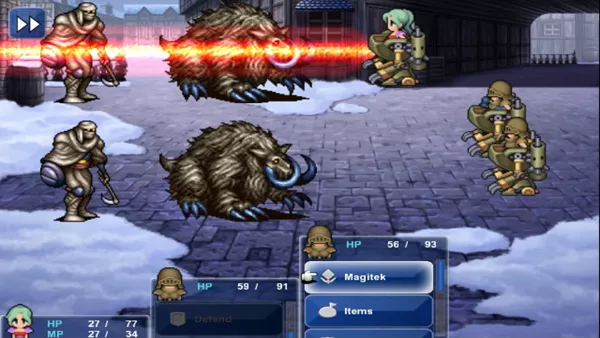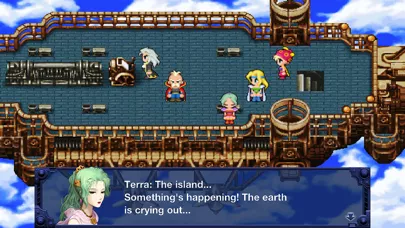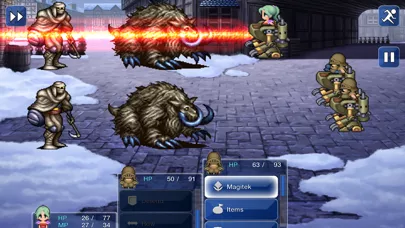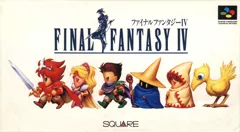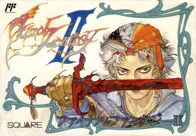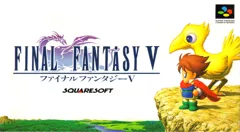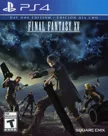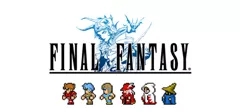Final Fantasy III
-
 Final Fantasy III
(1990 on
NES, 2009 on
Wii, 2014 on
Wii U)
Final Fantasy III
(1990 on
NES, 2009 on
Wii, 2014 on
Wii U)
-
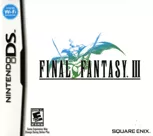 Final Fantasy III
(2006 on
Nintendo DS, 2011 on
iPhone,
iPad...)
Final Fantasy III
(2006 on
Nintendo DS, 2011 on
iPhone,
iPad...)
-
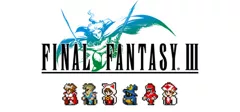 Final Fantasy III
(2021 on
Windows,
iPhone,
Android...)
Final Fantasy III
(2021 on
Windows,
iPhone,
Android...)
Description official descriptions
A thousand years ago, the War of the Magi occurred. People remember it as one of the most horrible tragedies in history. Since the War of the Magi, magic has been all but forgotten, technology began to grow, and people returned to seemingly normal lives. The only true worry people have is the Empire, whose leaders are looking to revive the great force once known as "magic".
The Empire had heard word of the remains of a mystical being, known as "Esper", being found in the mining town of Narshe. Quickly, three soldiers were dispatched to find this Esper and bring it to the Emperor. One of the soldiers, a young girl, triggers a power in the Esper that initiates a dangerous series of events. The only ones who can help her are a rag-tag band of rebels and heroes, who offer their very hearts and souls to save the world from the mad plans of the Empire.
The sixth entry in the Final Fantasy series was dubbed Final Fantasy III in the West because three out of the five previous installments of the series had not been released there at the time. Similar to its predecessors, this is a role-playing game where the player controls a party of characters, traveling between various locales in the world, fighting randomly appearing regular enemies and bosses, and making the characters stronger by improving their skills and getting better equipment for them. The game maintains the ATB (active time battle) system of the two previous installments in the series, spicing traditional turn-based combat engine with a real-time element.
In battle, every character can fight using weaponry and items, and each has a special combat skill as well. It is also possible for nearly every character to learn magic spells. By finding various Espers and equipping them on characters, the player can improve their parameters in different ways and choose the magic spells the characters should learn.
Unlike most other Japanese RPGs, the game does not have a single main character. Rather, the player-controlled party can be considered the game's collective protagonist. The first part of the game develops linearly, with one of the characters playing a central role; however, during the second part, the player is associated with a different character initially, exploring the game world, recruiting characters, and completing sub-quests in a non-linear fashion.
PlayStation re-release of the game includes new FMV cutscenes, bestiary, and artwork galleries. Game Boy Advance version and later Android, iOS, and PC releases remove FMVs but instead include two new bonus dungeons (the Dragons' Den and the Soul Shrine), new bosses, espers, weapons, and gear, as well as many other minor additions and changes.
Spellings
- ファイナルファンタジーVI - Japanese spelling
- 最终幻想6 - Simplified Chinese spelling
Groups +
- Boss Fight Books games
- Characters: Clowns, Mimes, and Harlequins
- Console Generation Exclusives: SNES
- Fantasy creatures: Dragons
- Final Fantasy games
- Final Fantasy series
- Gameplay feature: Arena fighting
- Gameplay feature: Bestiary
- Physical Bonus Content: World Map
- Protagonist: Female
- Theme: Haunted house
Screenshots
Promos
Videos
See any errors or missing info for this game?
You can submit a correction, contribute trivia, add to a game group, add a related site or alternate title.
Credits (SNES version)
64 People (48 developers, 16 thanks) · View all
| Producer | |
| Director | |
| Main Programmer | |
| Graphic Director | |
| Music | |
| Image Designer | |
| Battle Planner | |
| Field Planner | |
| Event Planner | |
| Effect Programmer | |
| Battle Programmer | |
| Sound Programmer | |
| Effect Graphic Designer | |
| Field Graphic Designer | |
| [ full credits ] | |
Reviews
Critics
Average score: 89% (based on 72 ratings)
Players
Average score: 4.1 out of 5 (based on 416 ratings with 8 reviews)
Great game but didn't fully satisfy my appetite
The Good
This review is about the sixth game of the Final Fantasy series, the well known epic jRPGs. This is the last game of what I'll call the "SNES trilogy" which is made of games Final Fantasy IV, V and VI.
The story is about Empire Gestra which oppress people, and how some of the spared nations continue to resist against it. You will control a group of rebel and fight to save people and resist the empire. While the story sounds very unoriginal, it is the developed characters and the way it is told which makes it much more interesting than it sounds at first.
This game features one of the largest character case of the Final Fantasy series with at least a dozen of character available. Unlike Final Fantasy V but like Final Fantasy IV, "jobs" (such as warrior, mage, monk, treasure hunter, etc...) are hardwired to protagonists of the game, which makes every character unique in his fighting style. However, you can also customise your character as wish because the system in this game allows to equip Espers (which is the name this game uses for summons). (This system is similar to the system that will be used later in Final Fantasy VIII). Depending on which summon you equip, you'll learn different spells (surprisingly, everyone can use black, white and time magic regardless of their jobs), and get different stat increases at level-up (in addition to the stat increases related to the job) which makes this system particularly powerful and interesting.
A good thing is that (like most of it's predecessors except FF4) this game has no such thing as a "Main protagonist", you could just have whoever you like in your party after some point in the story. However, it's sadly the last game of the series which lacks this "Main protagonist". Not that I don't like them, but it's nice you can have whoever you want in the party, and not be forced to have some guy just because he's the main protagonist.
Just like other Final Fantasy games, the controls are extremely intuitive and responsive, and are nothing to worry about. The menus are laid out in a way which makes perfect sense, and it's easy to equip your characters with items, etc, etc... (I just thought I'd mention that because this can't be said of all RPGs.) Save points are overall frequent enough and placed at appropriate locations.
This game have a weird Game Over system, where you will respawn at the last save point automatically, instead of loading the last saved state. From what I understand, EXP is kept but everything else is lost (I might be wrong). Apparently Square wanted to try something experimental, before going back again for the rest of the series. It doesn't make much of a difference, since you'll get most of your Game Overs at boss battles, and a save point is placed just before them in general, which means you didn't gain much EXP anyways.
Like the other games in the series, this game features many enemies and bosses you'll have to fight. While enemies are very often reused among different games of the Final Fantasy series, Final Fantasy VI is notable for not reusing anything from the previous games, and making it's own enemies from start. This is mostly a good thing, however, this game kind of break the tradition that was build up with the 5 first games. By the way, for the first time, elemental crystals are gone, too, which is sad because I just happen to love stories which are tightly coupled with the 4 elements. I don't know why but it's just a good old formula that never gets old. Well apparently Square decided it was getting old and, while elemental spells remain intact, the 4 elements are whipped out of the storyline (and will be wiped out for all following games of the series as far I can tell, except Final Fantasy IX where they play a minor role again).
Graphics are very well made for the time, we can immediately tell the developers played with the limitations of the SNES. Character sprites are slightly bigger than in the previous games, and are definitely more detailed. There is parallax scrolling and/or transparency effects everywhere. As you'd expect, summons are graphically very impressive. There is nothing to complain about this department, unless you are one of those guys who think that 2D graphics = bad graphics, in which case I have nothing to say to you.
However I must say that the mode-7 world map (mode 7 is a way for the SNES to fake 3D graphics) is a bit annoying. When you are by foot, the 3D effect is already there but it doesn't work as well as it was supposed to. When you are by airship, it really looks amazing. When you are by chocobo, they made it look like the airship view, where the camera is behind the chocobo, and this is absolutely terrible. Because the chocobo, and therefore the camera, is close to the ground, it makes the ground blend way too much for you to see where you are, and because this is not actual 3D but fake 3D, everything including building and mountains are "drawn on the ground", which in this case looks terrible. Thank god they fixed this in Final Fantasy VII and allowed you to manually switch between the "upper" view and the "behind" view (in addition to having true 3D). So, overall, the world map is globally OK, but it's the weakest point for the graphics of this game, and the effect there is when you ride a chocobo hasn't aged well.
Musically, this game is great and up to line with it's predecessors. The battle theme and boss theme are notably great, and the world map music is amazing, even my parents happens love it, despite them loathing video games in general ! There is even a particular musical piece for a special world map location, which is a nice addition to the game. I'll have to add to say that, however, some songs are more forgettable than songs in Final Fantasy IV and V. Not a big deal though, as this game still have overall incredibly good music. The sound effects are fine and do their work. There is nothing particular to say about them.
The Bad
Yet, I can't refrain from saying this game is overrated. So many people keep shooting "FF6 IS THE BEST RPG EVEEEER", but let me just tell, I think they're wrong. Many of them are biased because they played this first, and before the Final Fantasy series was well known to the masses in the western world. I can perfectly understand why they prefer this game if this is the game that made them discover this amazing series.
However, I played Final Fantasy VI the very last, after beating all the others of the series from Final Fantasy I up to Final Fantasy X-2 (FF7 being the one who made me discover the series). I had of course started games of Final Fantasy VI multiple times, but never had the urge to continue until more recently. Of course, I had high expectations, and for the most part, they were met, however, I will of course have a totally different viewpoint that one of someone who discovered this game in their early teens.
I must say that of course, this is a good game, but the story is one of the weakest of the series, which is mainly well known for it's great stories. If we consider just the SNES trilogy, the quality of the storyline were in my opinion decreasing as the entries of the series were increasing. The story of FF4 is fabulous, especially for it's time. The story in FF5 was a bit of a let down, as the villain had no reason to be a villain, but it was still good with developed characters and multiple worlds to discover.
In FF6, all we have is the cliche of an empire against rebellion group, and the cliche of the evil emperor's right arm (Cefka/Kefka in this case) which is in fact even more evil than the emperor himself. Also, like in FF5 but unlike FF7 for instance, the main opponent of the game has ZERO reasons to be evil. He just wants to bring shame and destruction for his own personal fun, and that's it. This is not what I'd call a very developed character. Sure Cefka/Kefka has the particularity of being an "evil joker" type of villain, something original in the Final Fantasy series.
Although we have a large character set, most of the playable characters do not feel like they are actually in the party. There is about 6 fully developed and interesting characters and 6 jokes/dummy characters with no personality at all (some of them can't even be equipped) who joins your party by pure chance, and couple of characters between those two extremes. Many characters joins you extremely late in the game, some of them can't be obtained until right before the last dungeon.
A large character case works for games like Suikoden which were designed with this in mind (and with the assumption you're going to use your favourite guys), but in the case of FF6 it didn't work as well. Most of the "dummy" characters are still somewhat useful in combat which makes them not as dummy as I am saying (for instance Umaro who is some sort of gorilla, can't be equipped, can't talk and can't be controlled in battle but he hurts enemies EXTREMELY hard, which always happens to be useful), but yet all those dummy character play zero role in the story, and the half-dummy characters play a very minor role once and that's all, which is disturbing to say the least.
One particular character has a command called "Blitz" which is used to make combat-game style gamepad combos. However, this command is very bugged and almost unusable, and therefore I made him out of my party as much as possible. Unfortunately, he's one of the "developed" character, so at multiple times you have to bring him in the party. Not that I don't like him, but I'd like being able to use his ability without getting mad frustrated...
None of this makes FF6 a bad game, not even a mediocre one, but I just see it as being overall a tad inferior to both it's predecessors and it's sequels.
The Bottom Line
Here is it. FF6 is a must play for anyone interested in jRPGs and the Final Fantasy series in general. Missing this great game would be an error. However, my opinion is that it's still definitely weaker than other games in the series, especially it's direct predecessor and sequel, FF5 and FF7, which are both extremely solid (and my personal favourites). FF6 is not the pinnacle of the series of the perfect game some people describe.
There is also not much reason to replay FF6 again when you're finished, but that's the case for RPGs in general.
SNES · by Bregalad (937) · 2013
A sometimes-cutesy, sometimes-macabre follow-up to Final Fantasy II
The Good
Final Fantasy III was a nice little game back in its day. The visuals were fancied-up from its predecessor (Final Fantasy II for North American gamers), the music was infused with some techno beats, and the storyline is just completely nutsoid in comparison to the elegant and compelling plot line that followed Cecil, Kain, and Golbez.
As close as I can figure, the ultimate baddie of this game, Kefka, is a hideous, unfunny clown with a penchant for wild and imaginative behavior, none of which makes a whit of sense to me.
FF3 does, however, sport a wealth of tertiary characters that join sides with our amnesiac green-haired protagonist, Terra.
For example, Celes is an ice queen with tremendous magical prowess and a woeful history of being used by 'The Empire', Kefka's organization. Cyan is a compelling dark-haired lord whose family has been slain, but who is not acting out of vengeance, but altruism. And Shadow is a ninja with a companion wolfhound and a black sense of humor. Some of the other characters are a little half-baked, a few are very wild, and in sum total there's much more variety in combat than in Final Fantasy II -- though I still prefer the latter for its elegant simplicity.
The score of FF3 is perhaps its strongest feature, and was composed by the inimitable Nobuo Uemetsu, whose work arguably declined in quality after this title. The key events in the story are all accompanied by a compelling musical piece, while battles and overworld travel are invigorated with one of many lively tunes.
My personal favorite is a rollicking jungle beat, which plays as your party travels across the Veldt, a savannah region populated by a variety of tame-able beasts. I can still remember just letting the game run, not doing anything, to listen to the track for a few minutes -- it's just that good.
The Bad
There's no flaw at all in Final Fantasy III, except that it's not as well thought-out as Final Fantasy II. It's still a great game, but the overall plot concept does not leave the player in a sublime state of satisfaction as its predecessor does. Simply put, Kefka is no Golbez. Also, needs more Crystals.
But... perhaps not. FF2 is FF2, and FF3 is FF3. It's just that the first features a far more sensible, interesting plot, while the second strays into some pretty zany territory. For example: a ghost train, an end-of-the-world cataclysm, mech suits, human experimentation and mind-control... and a few dinosaurs thrown in for good measure. It's an eclectic mix to be generous, and haphazard to be critical.
The Bottom Line
Hands down, Final Fantasy III is the finest RPG from the mid-90s, superior to anything else on the Super Nintendo, the PC, or the Genesis -- from the 1994-1997 period. 1993 gave us Betrayal at Krondor on the PC, a vastly deeper, richer game, and 1998 saw the release of one of my personal favorites, Baldur's Gate. FF3 did a great job of holding me over between these stellar releases for the PC.
So -- play it on an emulator today? Mmmm if you have a strong nostalgic hankering for one of the four finest RPGs on the SNES. I'll stick with Team Fortress 2 for now, personally.
And yes, the other three are FF2, Secret of Mana, and Chrono Trigger.
SNES · by Chris Wright (85) · 2010
Personally my favourite RPG of all time
The Good
- excellent soundtrack by the one and only Nobuo Uematsu. The music adds plenty of atmosphere and emotion to the game. Terra's theme is truly inspirational (heard in the intro and on the world map of the world of balance and some other places throughout the game).
- brilliant plot with many twist (one brilliant twist in particular, but can't give spoilers so you will just have to find out for yourself).
- characters all have unique abilities. All of them have personality helping the player to become more engaged into the story. There are characters you can care for like Terra and characters you hate such as the epic villain, Kefka.
- Many, many side-quests to uncover character backgrounds and extra items, etc to go with the 20 - 70 hours of fun you can get playing through the game depending on the amount of secrets, level building, etc you can be bothered with
- a generally all round classic RPG with great story, great characters, great music, and has to go down as one of the best games of all time.
The Bad
However the game isn't faultless:
- too many random encounters
- the story pretty much fades away after the world of balance (near the end of the game anyway though, which is pretty much all side-quests, so not that bad)
- leveling up system automatically levels up characters not in your party, and your characters gain more attributes when they have espers equipped making those levels gained without espers equipped semi-useless.
- maybe too many characters (i think about 14 or so including secret characters). Some of the characters you get too late on and don't develop much, e.g mog.
The Bottom Line
Snes version is better that playstation. The playstation one has extras such as fmv's but there are annoying loading times. A MUST play for all Japanese RPG and final fantasy fans. However some people find it hard to play 2-d RPGs in this day and age of 3-d brilliant graphics but they will only miss out on one of the best games in existence, some people even believe that all the newer final fantasy's have threw away all the good plots in exchange for graphics (except maybe FF7, of course). If you are like that then you should try Final Fantasy 7 - also a classic for playstation.
SNES · by Alan Yeung (3) · 2004
Discussion
| Subject | By | Date |
|---|---|---|
| Named wrong? | te_lanus (523) | Oct 7, 2018 |
| M A G I C | Simoneer (29) | Oct 1, 2010 |
| Holy crap. (another game music post) | J. P. Gray (115) | Jun 22, 2008 |
Trivia
1001 Video Games
Final Fantasy VI appears in the book 1001 Video Games You Must Play Before You Die by General Editor Tony Mott.
Characters
The names of some of the player-controlled characters were changed from their original Japanese counterparts: * Tina (ティナ) Branford became Terra Mash (マッシュ) Rene Figaro became Sabin Cayenne (カイエン) Garamonde became Cyan**
Development
Development of the game was rushed and several superbosses are included in the game's code but were not actually used. There are also several glitches in the game, possibly a result of the rushed development.
Extras
The European PlayStation release also contains the Final Fantasy X demo disc.
Manual
The game manual in the PlayStation version contains a major spoiler, by casually mentioning a major plot twist while listing the bonus content available after completion of the game.
Multiplayer
In the configuration menu of the original SNES release, characters can be set to either Controller 1 or Controller 2, making this in effect a two-player game. However, this control to the second player only works in battle and not on the overhead view maps or levels.
References
- In the SNES version (it is unknown if this applies to the PSX remake), the two soldiers that escort Terra at the beginning of the game are named Vicks and Wedge. This is a mistranslation, and a reference to Star Wars, where there are two pilots named Biggs and Wedge.
- Larry, Curly, and Moe are named after the slapstick comedy threesome The Three Stooges.
Sequel
Sometime in the mid-1990s, Square released several models showing off their new 3-D system. Much of what they used were characters and images from Final Fantasy VI, modeled into new 3-D. For this reason many people were expecting a sequel using these same characters or some kind of spin-off game. Much speculation was around Project Reality (the Nintendo 64) which promised to be a console system built around rendering 3-D graphics. In the end, nothing developed from these rumors about Final Fantasy VI and Square's following game in the series, Final Fantasy VII became the first to use 3-D modeling techniques.
Setzer
One of the main characters in this game is an avid gambler named "Setzer" (he even has a casino build on his airship). Supposedly, this was meant to be the German equivalent of "one who places a bet" or "placer". While it technically means this in German, it is never used that way; "Setzer" is rather used for "typesetter" (well, not that typesetters are common nowadays anyway). Yet another example of Japanese usage of German "names".
Soundtrack
The entire 25-minute opera sequence is available on CD as played by a full orchestra with singers. It's on the album Orchestral Game Concert #4, (translated, CD is Japanese) which is, itself, hard to find.
There have been multiple albums released with the game's soundtrack, all of them in 1994: a three-CD set with the original music, two CDs with orchestral and piano arrangements of certain tracks, and a CD with unused or remixed tracks. More details are to be found at Wikipedia.
Translation
It is a popular rumor that the lead translator for the English version, Ted Woolsey, apparently lacked professional translating experience. The discrepancies in translations have been attributed to this fact for several years. As with many translations, name changes and dialogue 'corrections' are left entirely up to the staff, but there are many who believe that these erroneous changes are due entirely to the fact that Ted did not have the knowledge to translate the text fully.
Version differences
There were two SNES releases of Final Fantasy III, the later release contains minor hardware revisions, as well as tweaks to the game itself such as the disappearance and renaming of certain items (Hero Ring, etc).
In the original SNES release of the game, Relm's "Sketch" ability is very buggy. Using it consistently against certain enemies can cause all sorts of interesting problems such as graphical distortions, random status effects and/or inability to use party members, a hacked inventory full of items/spells that are not even possible to get, large amounts of various items/spells and sometimes even a wipe of all the game's saved battery data.
Awards
- Electronic Gaming Monthly
- October 1994 (Issue 63) - Game of the Month
- 1995 Buyer's Guide - Best RPG
- 1995 Buyer's Guide - Best Music (Cartridge Format)
- 1995 Buyer's Guide - Best RPG (Japanese)
- November 1997 (Issue 100) - ranked #7 (Readers' Top 10 Games of All Time)
- November 1997 (Issue 100) - ranked #9 (Best 100 Games of All Time)
- FLUX
- Issue #4 - #28 in the "Top 100 Video Games of All-Time" list
- GameFan
- 1994 (Vol.3, Iss.1) - Overall RPG Game of the Year
- 1994 (Vol.3, Iss.1) - Best SNES RPG Game of the Year
- 1994 (Vol.3, Iss.1) - Best SNES Music
- Game Informer
- August 2001 (Issue #100) - #7 in the "Top 100 Games of All Time" poll
- Game Players
- January 1995 - Best SNES RPG Game in 1994
- GameSpy
- 2007 – #4 Handheld Game of the Year
- 2007 – GBA Game of the Year
- 2007 – GBA RPG of the Year
- VideoGames
- March 1995 - Best Role-Playing Game of the Year
Analytics
Upgrade to MobyPro to view research rankings!
Related Sites +
-
FF-Fan
A fansite that offers all kinds of information on the entire Final Fantasy franchise, including walkthroughs, game media, discussion boards and fan art. -
Final Fantasy Compendium
Contains an insane amount of information on every Final Fantasy game and the series in general. -
Final Fantasy Extreme
Site that contains movies, wallpaper, codes, guides, walkthroughs, and general information on the Final Fantasy series. -
Final Fantasy Online Strategy Guides
Tips, tricks, walkthroughs, and just really useful information for Final Fantasy VI. -
GameFaqs Files
FAQs, Walkthroughs, multiples guides... -
Wikipedia: Final Fantasy VI
Information about Final Fantasy VI at Wikipedia
Identifiers +
Contribute
Are you familiar with this game? Help document and preserve this entry in video game history! If your contribution is approved, you will earn points and be credited as a contributor.
Contributors to this Entry
Game added by Satoshi Kunsai.
Android added by Fred VT. Windows, PS Vita added by GTramp. Wii U added by Michael Cassidy. iPad, iPhone added by firefang9212. Fire OS added by Sciere. Wii added by Joshua J. Slone. Game Boy Advance added by Unicorn Lynx. PlayStation 3, PSP added by MAT.
Additional contributors: Roedie, Unicorn Lynx, SAGA_, Alaka, Mobygamesisreanimated, Bregalad, Havoc Crow, DarkDante, Big John WV, DreinIX, —-, Patrick Bregger, FatherJack, 64er.
Game added October 22, 2001. Last modified May 29, 2024.
